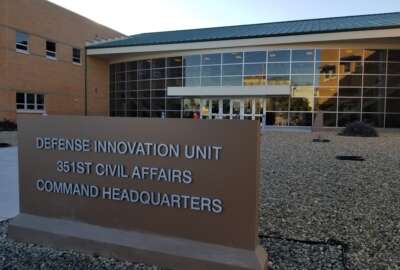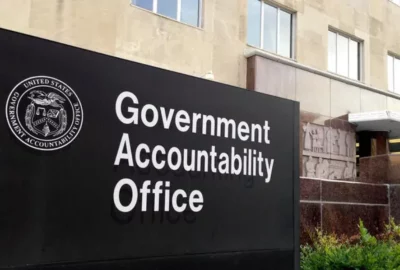Hubbard Radio Washington DC, LLC. All rights reserved. This website is not intended for users located within the European Economic Area.
E-Government Act helped usher in a new approach to federal IT
The 10-year-old law created a centralized oversight and advocate in OMB for IT management and programs. It also focused on making the government more citizen-ce...
wfedstaff | April 17, 2015 4:29 pm
To understand the true impact of the E-Government Act of 2002, look no further than the regulations.gov website.
The portal lets citizens and others find and comment on proposed rules or interim rules. But, maybe more importantly, the site also shows how the government has moved over the last decade to become more citizen-centered and collaborative.
Basically, regulations.gov and many other websites and initiatives are proof of the impact of the E-Government Act of 2002.
It was 10 years ago Monday that President George W. Bush signed the bill into law. 
Kevin Landy, the staff member who worked on the bill for its author Sen. Joseph Lieberman (I-Conn.), said there were some sporadic efforts to change the way the government interacts with citizens. For example, Lieberman had an online portal developed to ask for ideas from the public to change the government’s approach to serving the public.
Landy said those ideas became the launching point for the bill, which Lieberman introduced in May 2001.
“I think there were two central aspects to it. One was the core notion we all think of when we think of e-government, streamlining, access for citizens to information and services, breaking through agency stovepipes so that the information is organized according to the needs of the citizen and not according to the organization of the agency,” Landy said Monday, during a panel discussion in Washington hosted by the Information Technology and Innovation Foundation. “Then, in order to effectuate that, you need centralized, effective leadership coming out of the Office of Management and Budget. For that, the E-Government Act legislation created a very strong chief information officer position at OMB that would have extraordinary powers to lead intergovernmental efforts.”
Section 207’s lasting impact
He added the reorganization of OMB helped ensure agencies were moving in the right direction.
Karen Evans, the second OMB administrator for e-government and IT, came to her position in 2003 and was responsible for implementing the law.
She said agencies and OMB had a lot to do under the law, including updating privacy regulations, ensuring the federal IT workforce was training properly and addressing common standards for geographic information systems.
But it was Section 207 of the bill that really stood out in its impact on government.
Dan Chenok, the former OMB career staff member who handled the negotiations with Congress and now is executive director at the IBM Center for the Business of Government, said there are several reasons why Section 207 has had a lasting effect on agencies. 
The law included another section that also laid the foundation for the how the government uses technology.
The Federal Information Security Management Act (FISMA) was the last major piece of cyber legislation passed by Congress in the last 10 years.
Chenok said FISMA’s long term impact has been greater than expected when it was passed.
“Because of the introduction of FISMA into the overall statute, it created on the Privacy Impact Assessment, a framework for security and privacy to enable IT advances,” Chenok said. “It was something that was core in the same statute. So it wasn’t like you had a security law here and an e-government law over here, they were really seen as part of an information technology whole.”
Not everything succeeded
Evans said the acquisition and the security provisions also helped the federal government work more closely with state and local governments.
She said both parts of the law helped forced integration between governments, especially in the procurement area. 
OMB also struggled to convince Congress to give them adequate money for the E-Government Fund. Evans said during her tenure at OMB, Congress never approved more than $3 million in any one year.
The Obama administration has had more success in convincing Congress of the benefits of the E-Government Fund, receiving $12.4 million in 2012 and $34 million in 2010.
Landy said the fund could have given OMB a much-need boost during the first few years the White House implemented the law.
Both the Bush and Obama administrations have struggled also to meet the requirements to share data more easily between and among statistical agencies.
While the E-Government Act ushered in a new era of federal IT, the panelists discussed what the next decade will bring and whether the law is sufficient enough to handle it.
Rep. Darrell Issa (R-Calif.), chairman of the Oversight and Government Reform Committee, is writing a bill to update agency technology management again, building on the E-Government Act and the Clinger-Cohen Act of 1996.
New models for federal IT
Mark Forman, the first OMB administrator for e-government and IT and now co-founder of Government Transaction Services, which helps agencies manage the grant process better, said the government is moving toward a new productivity model.
He said there are several pieces to the model, including knowing what data is available and making it easily accessible, which is something the E-Government Act called for.
The second area is the commoditization of IT and the move to shared services, Forman said.
“The real issue here has IT rapidly become a service, and the services are commoditized, they tend to be transactional,” he said. “The government hasn’t quite figured this out yet, but it will over the next 10 years, and it will understand what is the service the government is supposed to provide, how much of that service is a utility that can be highly automated and how much of it is knowledge based, and what is the government’s cataloged services?” 
“The productivity of the government employee operating in a silo is a model of the 20th Century,” he said. “In the 21st Century, the model has to be real time assembly of the people who have the insights. I believe the one metric is the response time for government. How fast does it take for government to make a decision?”
Forman said one of the most important changes that needs to happen is in the area of identity management. He said there have been several initiatives, e-authentication, Homeland Security Presidential Directive-12 and now the National Strategy for Trusted Identities in Cyberspace (NSTIC), to deal with the need to verify and authorize access to information and systems.
None of the programs have caught on enough to solve the identity management challenge, Forman said.
Culture needs to change more
Doug Bourgeois, the chief cloud officer for VMWare public sector, and the former director at the Interior Department’s National Business Center, said the culture about the role of IT needs to change and that will happen over the next decade.
“The role of IT is now becoming that of a true service provider. But most IT organizations were not structured, were not cultured, were not staffed and are not led in a way that is conducive to delivery as a service,” he said. “So the fundamental transformation that needs to occur, while it’s happening now at the technological level with cloud computing, needs to go way beyond that to the organizations that are leveraging technology for the good of the overall mission.”
The panelists said the E-Government Act helped start some of the culture change, but more needs to happen.
Forman said agencies need to reduce the number of applications they support or the government will receive only minor benefits and cost savings from the data center consolidation effort.
Additionally, the panelists said lot of expectation exists around how these innovations in technology from cloud or mobile computing will help with the big data problem. Some of the panelists said health care and national security are the two areas that will benefit the most from this technology.
RELATED STORIES:
E-gov fund gets boost in spending bill
E-government’s promise partially fulfilled
Agencies to cut billions in commodity IT spending
IT reform bill would cull the CIO herd, give them more power
Copyright © 2024 Federal News Network. All rights reserved. This website is not intended for users located within the European Economic Area.
Jason Miller
Jason Miller is executive editor of Federal News Network and directs news coverage on the people, policy and programs of the federal government.
Follow @jmillerWFED
-
A look at the origins of the Defense Innovation Unit Federal Drive
-
GAO reviews how the VA is training its claim processors Federal Drive





